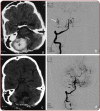Multimodality Treatment of Low-Grade Ruptured Brain Arteriovenous Malformations Presenting with Life-Threatening Intracranial Hematoma
- PMID: 34221166
- PMCID: PMC8224719
- DOI: 10.26574/maedica.2020.16.1.112
Multimodality Treatment of Low-Grade Ruptured Brain Arteriovenous Malformations Presenting with Life-Threatening Intracranial Hematoma
Abstract
Introduction:Acute management of low-grade but life-threatening ruptured arteriovenous malformations (AVM) with simultaneous hematoma evacuation remains controversial. The current report aimed to present a case series of multimodality management of low-grade (Spetzler-Martin I-II) but life-threatening ruptured arteriovenous malformations. Methods:A consecutive case series of six Spetzler-Martin (SM) grade I-II ruptured AVM patients with concurrent life-threatening hematoma initially treated with hematoma removal and, when possible, with simultaneous AVM extirpation is presented. Supplementary treatment was also applied when deemed necessary. Median clinical follow-up was 15.6 months. Neurological assessment was performed on admission (Glasgow coma scale score - GCS) and at final follow-up (modified Rankin scale score - mRS). Results:Intraparenchymal hematoma was evacuated in all six cases, with simultaneous AVM extirpation in three cases. Preoperative embolization was done in one patient, whereas postoperative embolization was performed in three additional patients. Supplementary radiosurgery was applied in one patient. Complete AVM occlusion was achieved in all patients. At the final follow-up (15.6 months), 33.3% of patients were asymptomatic, 50% had a non-significant or slight disability (mRS score 1-2), whereas one patient died. All patients with preoperative GCS score of 8 or higher had a favorable outcome. Conclusion:Acute surgical hemorrhagic clot evacuation as first step, followed by simultaneous AVM extirpation when feasible, may result in favorable clinical outcome in ruptured low-grade (SM I&II) brain AVMs with life-threatening hematoma. Embolization has a supplementary role in the acute phase of treatment either by either securing the bleeding source preoperatively or occluding the residual malformation especially in cases of technically demanding AVM removal.
Figures





References
-
- . European Lung White Book. www.erswhitebook.org, Chapter 21, p. 138.
-
- Gupta R. JAMA Netw Open. 2019.
-
- Julia V, Macia L, Dombrowicz D. The impact of diet on asthma and allergic diseases. Nature Reviews Immunology. 2015;15:308–322. - PubMed
Publication types
LinkOut - more resources
Full Text Sources
